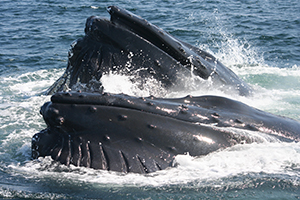Biologist Reveals How Whales May ‘Sing’ for Their Supper

A photo of humpback whales taken by Susan Parks
Susan Parks, assistant professor of biology in the College of Arts and Sciences, in collaboration with a consortium of other researchers, has been studying these unique feeding behaviors. Her research emphasizes the importance of specific auditory cues that these mammoth creatures emit as they search the deep ocean for their prey.
Her findings are the subject of an article in the December issue of Scientific Reports (“Evidence for acoustic communication among bottom foraging humpback whales,” 2014), co-authored by researchers at Moss Landing Marine Laboratories, Oregon State University, Gerry E. Studds Stellwagen Bank National Marine Sanctuary and the Whale Center of New England.
“Humpback whales are known to cooperate with others to corral prey near the surface,” says Parks, who studies marine science and acoustic communication. “Recent studies suggest they may cooperate [with each other], when feeding on bottom prey, as well.”
Parks was part of a collaborative multi-institutional consortium that has spent a decade monitoring humpback feeding behaviors in the Gerry E. Studds Stellwagen Bank National Marine Sanctuary, off the coast of Massachusetts. Whales were tagged with special underwater recording devices so Parks could determine how specific acoustic sounds correlated with successful seafloor feeding.
The investigation revealed that whales make “tick-tock” noises while hunting together at night in deep, pitch-black water, but are silent when hunting alone.
On the menu? Mostly sand lance—eel-like fish known to bury themselves in the sand of the ocean floor. Parks suggests that whales' vocal sounds may help flush the sand lance out of hiding to where they're scooped up and eaten.
The clock-like sounds created by whales may also serve as a dinner bell of sorts for other nearby whales during late-night feedings.
“Hints of behavior suggest that other whales who overhear the sounds are attracted to them and may eavesdrop on other whales hunting for food,” Parks adds.
Prior to joining Syracuse's faculty in 2011, Parks held various appointments at Pennsylvania State University, Cornell University and the Woods Hole Oceanographic Institution. She is the recipient of numerous honors and awards, including the Presidential Early Career Award for Scientists and Engineers, the U.S. government's highest honor for scientists and engineers.
Media Contact
All latest news from the category: Life Sciences and Chemistry
Articles and reports from the Life Sciences and chemistry area deal with applied and basic research into modern biology, chemistry and human medicine.
Valuable information can be found on a range of life sciences fields including bacteriology, biochemistry, bionics, bioinformatics, biophysics, biotechnology, genetics, geobotany, human biology, marine biology, microbiology, molecular biology, cellular biology, zoology, bioinorganic chemistry, microchemistry and environmental chemistry.
Newest articles

Sea slugs inspire highly stretchable biomedical sensor
USC Viterbi School of Engineering researcher Hangbo Zhao presents findings on highly stretchable and customizable microneedles for application in fields including neuroscience, tissue engineering, and wearable bioelectronics. The revolution in…

Twisting and binding matter waves with photons in a cavity
Precisely measuring the energy states of individual atoms has been a historical challenge for physicists due to atomic recoil. When an atom interacts with a photon, the atom “recoils” in…

Nanotubes, nanoparticles, and antibodies detect tiny amounts of fentanyl
New sensor is six orders of magnitude more sensitive than the next best thing. A research team at Pitt led by Alexander Star, a chemistry professor in the Kenneth P. Dietrich…





















